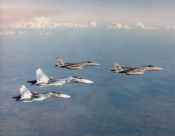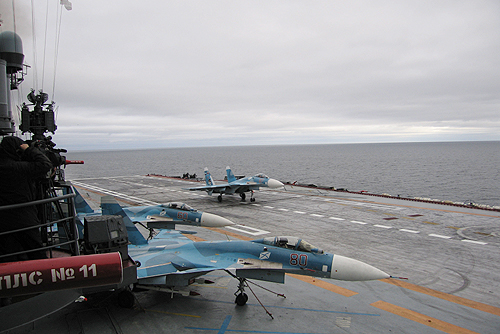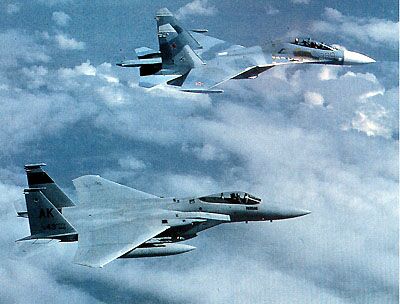1. Kann man noch nicht genau sagen. Schon möglich, dass es eine Flugzeugträger-Variante T-50 geben wird.
Schon im Oktober 2010 hat man angefangen SU-33 Maschinen zu modernisieren.
SU-33 an Bord der Admiral Kusnezow:
Zudem könnte es zum Einsatz von MIG-29K/KUB kommen:
2. T-50 ist ein Kampfjet der 5-Generation. SU-35S gehört zur Generation 4++, besitzt aber geringe Radarsignatur und wird unter Verwendung der Technologien der fünften Generation gebaut. Somit ist er den anderen Jets dieser Klasse deutlich überlegen. Was die Manövrierfähigkeit angeht, da hat SU-35BM so gut wie keine Konkurrenz (außer SU-30). Warum? >>>
Unique pilotage Su-35 at MAKS-2011 - YouTube
MAKS-2011 (
Su-35 thunderstorm at MAKS 2009 - YouTube
DAS BESTE WAS MAN HEUTZUTAGE IN DER LUFT ZU SEHEN BEKOMMT!
Zum Vergleich:
Sukhoi Su-30MK2
YouTube - Sukhoi Su-30MK2
Sukhoi Su-30M
YouTube - Sukhoi Su-30M
MIG 29 ILA AIRSHOW
YouTube - MIG 29 ILA AIRSHOW
Mig 29 OVT Thrust vectoring (closeup and display) at RIAT'06
YouTube - Mig 29 OVT Thrust vectoring (closeup and display) at RIAT'06
(HD) F-22 RAPTOR DEMO 2010 - RIAT (airshowvision)
YouTube - (HD) F-22 RAPTOR DEMO 2010 - RIAT (airshowvision)
Discovery - F22 vs SU-37
YouTube - Discovery - F22 vs SU-37
Eurofighter Typhoon
YouTube - Eurofighter Typhoon
ILA Berlin Air Show 2010 - Eurofighter
YouTube - ILA Berlin Air Show 2010 - Eurofighter
RAFALE SOLO DISPLAY / The Dark Knight [Full HD] 2011
RAFALE SOLO DISPLAY / The Dark Knight [Full HD] 2011 - YouTube
MiG-35 at MAKS 2007 2009
MiG-35 at MAKS 2007 2009 - YouTube
Auch eine wunderschöne Kampfmaschine.
Weitere Videos mit SU-30:
Su-30MK at MAKS 2007 2009
Su-30MK at MAKS 2007 2009 - YouTube
Sukhoi Su-30
Sukhoi Su-30 [HD 720p] | srdjanHD - YouTube
Trotz ihrer Größe und ihres hohen Gewichts ist die Su-30 zu bemerkenswerten Flugleistungen fähig. Dazu gehört unter anderem das mit einer Su-27 erstmals demonstrierte und seitdem berühmte
Kobramanöver. Im Vergleich zur Su-27 erreicht die Su-30 allerdings eine etwas geringere Steigleistung und Höchstgeschwindigkeit. Bei Manövern mit sehr abrupten Richtungsänderungen verliert sie enorm an Geschwindigkeit und somit auch Höhe, was vor allem bei Versionen mit Schubvektorsteuerung, die die Wendigkeit der Maschine gegenüber Flugzeugen mit konventionellen Triebwerken stark erhöhen, besonders deutlich wird. Die Stärke der Su-30 liegt primär auf ihrer hohen Flexibilität, da sie beinahe für jede Art von Einsatz verwendet werden kann. Diese sogenannten „Multi-Role“-Fähigkeiten sind der größte Vorteil der Su-30MK auf dem Weltmarkt, da bisher nur die
F-16,
F-18 und
Saab JAS-39 Gripen über eine ähnliche hohe Flexibilität verfügen, ohne aber die Flugleistungen der Su-30 zu erreichen. Dies könnte sich aber mit der Einführung der
F-35 sowie der vollen Einsatzfähigkeit der französischen
Rafale und des
Eurofighter Typhoon ändern.
Su-30MK Beats F-15C 'Every Time'
By David A. Fulghum and Douglas Barrie
[May 24, 2002]
The Russian-built Sukhoi Su-30MK, the high-performance fighter being exported to India and China, consistently beat the F-15C in classified simulations, say U.S. Air Force and aerospace industry officials.
In certain circumstances, the Su-30 can use its maneuverability, enhanced by thrust-vectoring nozzles, and speed to fool the F-15's radar, fire two missiles and escape before the U.S. fighter can adequately respond. This is according to Air Force officials who have seen the results of extensive studies of multi-aircraft engagements conducted in a complex of 360-deg. simulation domes at Boeing's St. Louis facilities.
"The Su-30 tactic and the success of its escape maneuver permit the second, close-in shot, in case the BVR [beyond-visual-range] shot missed," an Air Force official said. Air Force analysts believe U.S. electronic warfare techniques are adequate to spoof the missile's radar. "That [second shot] is what causes concern to the F-15 community," he said. "Now, the Su-30 pilot is assured two shots plus an effective escape, which greatly increases the total engagement [kill percentage]."
THE SCENARIO in which the Su-30 "always" beats the F-15 involves the Sukhoi taking a shot with a BVR missile (like the AA-12 Adder) and then "turning into the clutter notch of the F-15's radar," the Air Force official said. Getting into the clutter notch where the Doppler radar is ineffective involves making a descending, right-angle turn to drop below the approaching F-15 while reducing the Su-30's relative forward speed close to zero. This is a 20-year-old air combat tactic, but the Russian fighter's maneuverability, ability to dump speed quickly and then rapidly regain acceleration allow it to execute the tactic with great effectiveness, observers said.
If the maneuver is flown correctly, the Su-30 is invisible to the F-15's Doppler radar--which depends on movement of its targets--until the U.S. fighter gets to within range of the AA-11 Archer infrared missile. The AA-11 has a high-off-boresight capability and is used in combination with a helmet-mounted sight and a modern high-speed processor that rapidly spits out the target solution.
Positioned below the F-15, the Su-30 then uses its passive infrared sensor to frame the U.S. fighter against the sky with no background clutter. The Russian fighter then takes its second shot, this time with the IR missile, and accelerates out of danger.
"It works in the simulator every time," the Air Force official said. However, he did point out that U.S. pilots are flying both aircraft in the tests. Few countries maintain a pilot corps with the air-to-air combat skills needed to fly these scenarios, said an aerospace industry official involved in stealth fighter programs.
Those skeptical of the experiments say they're being used to justify the new Aim-9X high-off-boresight, short-range missile and its helmet-mounted cuing system, the F-22 as an air superiority fighter and, possibly, the development of a new long-range air-to-air missile that could match the F-22 radar's ability to find targets at around 120 mi. They contend that the Su-30MK can only get its BVR missile shot off first against a large radar target like the F-15. While it's true that the Su-30 MK would not succeed against the stealthy F-22 or F-35, neither would it regularly beat the nonstealthy (but relatively small radar cross section) F-16 or F/A-18E/F, they said. These analysts don't deny the F-22's value as an air-to-air fighter, but say the aircraft's actual operational value will be greatest in the penetrating strike, air defense suppression and electronic jamming roles.
At the same time, there may be more to the simulations than justifying new weaponry, say European analysts. Also at play are some tactical wrinkles being developed for the more effective use of new Russian missile versions.

Russian Su-27UBs formate with USAF F-15s. While Ex Cope India was the first fully documented DACT with these aircraft, some sources claim that some informal exchanges took place one such visit by Flankers to USA. However this is hotly disputed by others.
The combination of Su-30 and R-27ER/ET (NATO designation AA-10), flown and fought in a competent fashion, also represents a significant threat. Even though the R-27ER is only a semiactive radar-guided missile, the extra maneuvering capability resulting from the large motor is a significant improvement over the basic R-27. Basic Russian air force doctrine has long suggested following a semi-active missile launch immediately with an IR missile launch, such as the R-27ET. Theory has it that the target aircraft's crew will be occupied spoofing the inbound radar missile, only to fall to the second missile.
The R-27ER, while only semiactive, also outperforms the baseline R-77 ( AA-12) in terms of kinematics. The R-77 motor has a simple, and short, burn profile, which has resulted in disappointing performance, piquing the Russian air force's interest in developing the K-77M rather than fielding the basic AA-12 in any numbers. The K-77M (K denotes a missile still in development, while R reflects an inventory weapon) is an upgraded R-77 with improvements that include a larger motor with a burn sequence profiled to increase range.
The oft-touted, but yet-to-be-fielded, R-27EA active variant of the AA-10 could further enhance the Su-30's capabilities, were an export customer to buy the derivative. In terms of one-on-one combat, the second-generation Flanker family presents a considerable threat to aircraft not designed from the outset as low observable, unless they are capable of extended-range BVR missile engagements. For instance, this threat drove the British selection of a rocket-ramjet missile to equip the Eurofighter.





 Hast deine Hausaufgaben wieder nicht gemacht, weil, wie man sieht, deine Infos ganz schon alt sind und hier wirklich keinen weiterbringen. Mach dir mehr Mühe. Besorge die Infos nicht nur im Internet. Es gibt genug andere Quellen zum Vergleich.
Hast deine Hausaufgaben wieder nicht gemacht, weil, wie man sieht, deine Infos ganz schon alt sind und hier wirklich keinen weiterbringen. Mach dir mehr Mühe. Besorge die Infos nicht nur im Internet. Es gibt genug andere Quellen zum Vergleich.

